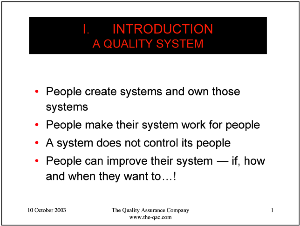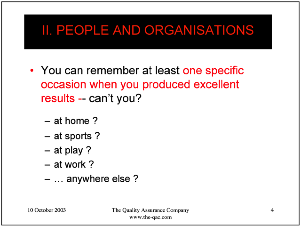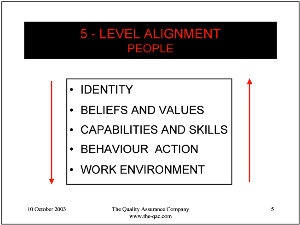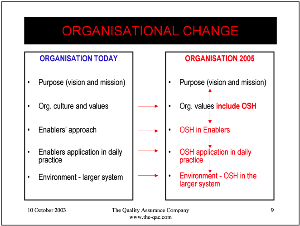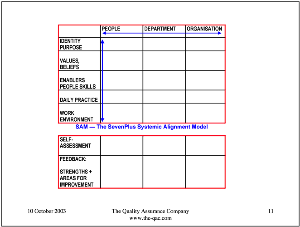
SAM - SevenPlus systemic alignment model*
1. People create systems - we can change what we create ...
If people and the system do not “fit” each other - then adapt the system or ourselves !!
We will do that if:
we believe in harmony
we want harmony
we are able to establish harmony.
2. Things don’t work out as planned when:
•people do not identify themselves with the processes they use -
•they do not believe in the processes -
•they do not know how to use them -
•their work environment does not allow them to use those processes.
Consequently — the results will only be average - not excellent !
3. On that specific occasion:
Take your time to re-experience that specific occasion; use your 5 senses to make it real: what you saw, heard, felt, and maybe smelled, tasted at that time…
•Where were you?
•What were you doing… with what skills?
•How did you learn those skills?
•What was important to you on that occasion? What motivated you to learn those skills?
•Who were you at that time
4. On that specific occasion you were perfectly aligned at all 5 levels. But what happens when you are not aligned at 5 levels? For example, what if…
•you do not believe in what you are doing; it is not important for you.
•you do not have the required capabilities and skills.
•Work environment - relations with the people you are with are not optimal; the physical location or building does not suit you...
... Can you still produce your very best?
5. To produce excellent results, organisations should also be aligned at 5 levels …
The enablers are those described in the European Excellence Model (see www.efqm.org).
6. Let’s put people and the organisation together. For example:
Do you believe in the organisation’s values?Do you “fit” into its culture….?
Do you have the skills to apply the “Enablers”….
…. in daily work practice ?
7. We live in an environment of constant change - be it the world, or the system in which we work, or our “self”.
The environment - the organisation’s larger system - changes for example through the introduction of occupational safety and health (OSH) as a value and as part of daily work practice.
Then alignment is disturbed — at which levels?
8. What happens when you introduce a new value - OSH - in the organisation?
How will it affect:
•Leadership, policy and strategy, people management and people skills, resource management, - suppliers, procedures?
•daily life practice?
•physical environment, relations with the larger system in which the organisation is active?
How will alignment at 5 levels be re-established in the system?
9. How will you be affected?
At which levels?
What will you do?
10. SAM is about systemic alignment with people at the centre.
It is a diagnostic and self-assessment tool - providing feedback for learning and continuous improvement - through strategic planning.
It enables horizontal and vertical alignment at 5 levels - - between people, department(s) and the organisation as a whole.
★ SAM has its roots in the work of Gregory Bateson on learning processes and of Robert Dilts onneurological levels. It has been developed together with Marianne Kjaer and others from the SevenPlus Network Europe.
